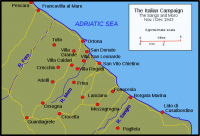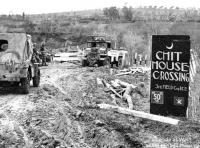Background
On 6 December 1943, the 1st Canadian Infantry Division under Major-General Chris Vokes, a Sapper, began a series of assaults on major crossing points along the Moro River along the eastern coast of Italy. The attacks were led by three infantry battalions and fighting was hard for two days and established two small bridgeheads over the Moro River. On December 8th, Vokes adjusted his plan to consolidate a larger bridgehead by launching a two-pronged attack out of the two smaller bridgeheads. The attack began in the afternoon with a massive artillery barrage with infantry following. During the night of 8/9 December, units of the Royal Canadian Engineers (RCE) built a bridge over the Moro allowing armour and equipment to move into San Leonardo the following day.
Role of the RCE
The importance of the RCE in the Moro River Crossing is clearly illustrated by the fact three medals for gallantry were awarded to members of the 3rd Field Company that night. The following from History of the Corps of Royal Canadian Engineers, Vol II, describes their actions from a Sapper point of view.
The attack went in on schedule but the infantry did not have things all their own way. At 1800 hours, although the 3rd Field Company had not yet received a success signal, Major Fraser decided that he could wait no longer. He sent a D-7 bulldozer and two sections off "to see what happens", the former sounding like a regiment of tanks! Nothing happened, and the operation was on. The near bank needed no heavy grading, so the bulldozer operator, Sapper M. C. McNaughton, was sent off to find his own route across the river. This he accomplished by moving up a draw, although he became silhouetted against the sky at one point and came under prompt machine-gun fire. At 2030 hours he started cutting down the far bank — a formidable cut varying from zero to 12 feet in a length of 80 feet. This took about seven hours. Construction of the near approach was sufficiently advanced by 2000 hours to enable the materials for a culvert to be brought forward. Over the culvert, a six-foot-high causeway was built. The dozers finished this task by 0400 hours. The crossing was ready for use by tanks at 0600 hours. Although the deviation came under shell, mortar and machine-gun fire at frequent intervals during the night, there were only three sapper casualties, and these but slightly wounded. Enemy fire, however, increased greatly after 0700 hours when the tanks finally began to clatter across and, during the morning, company maintenance parties had 22 wounded and one killed. For this operation, Major Fraser was awarded the Distinguished Service Order and Sergeant O. L. Mellick and Sapper McNaughton each the Military Medal. General Montgomery personally congratulated the C.R.E.

